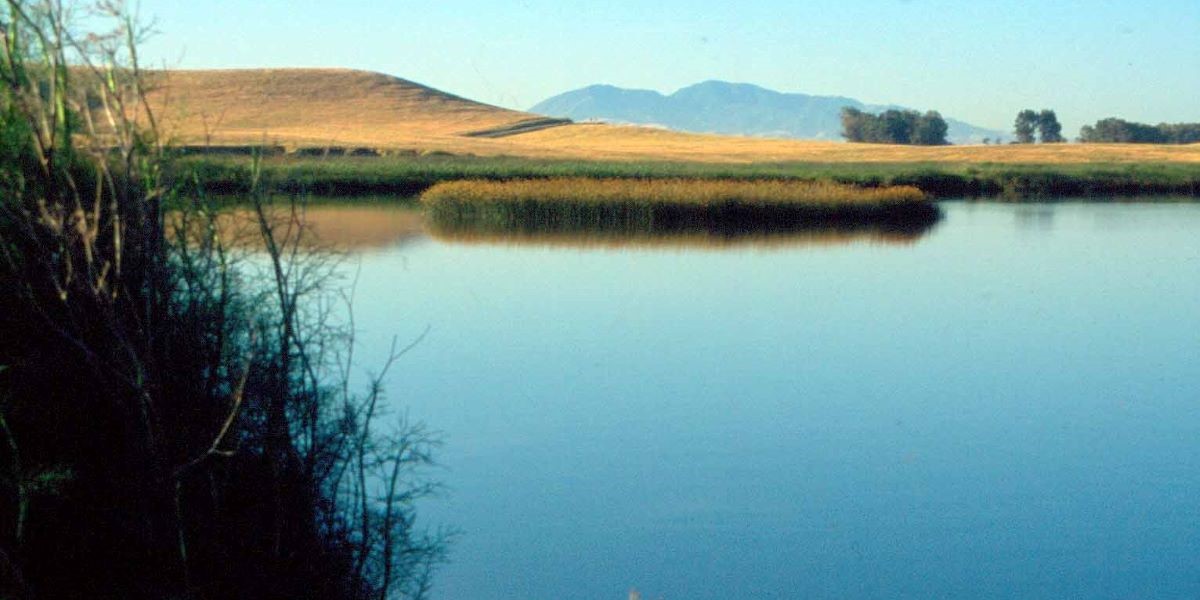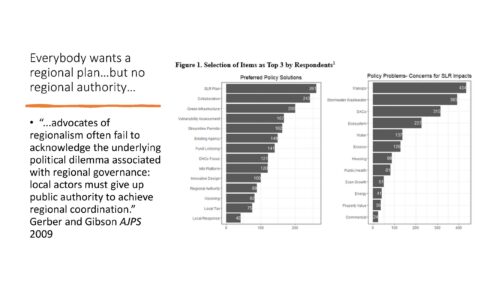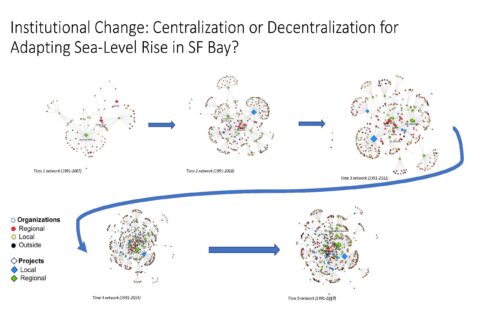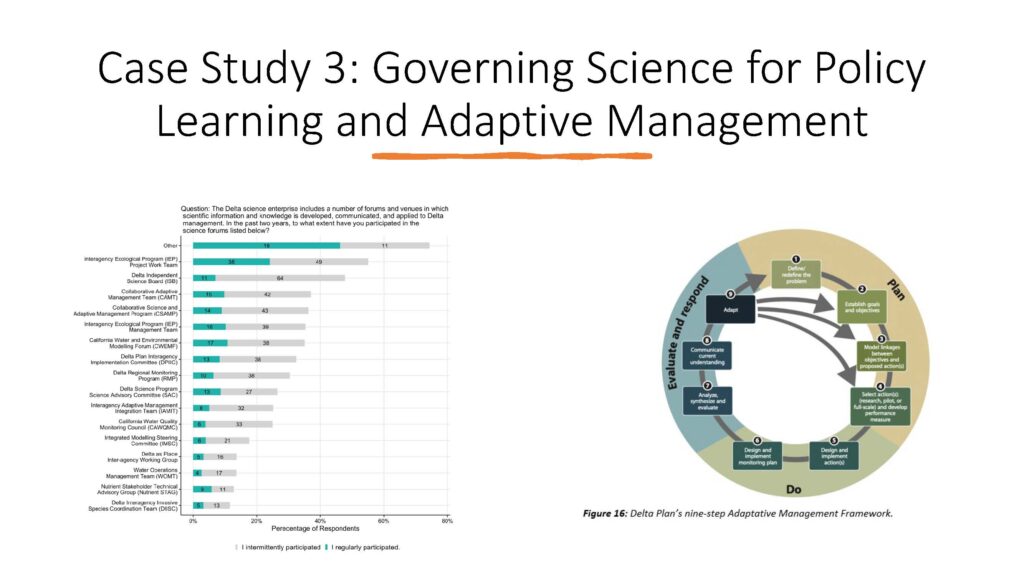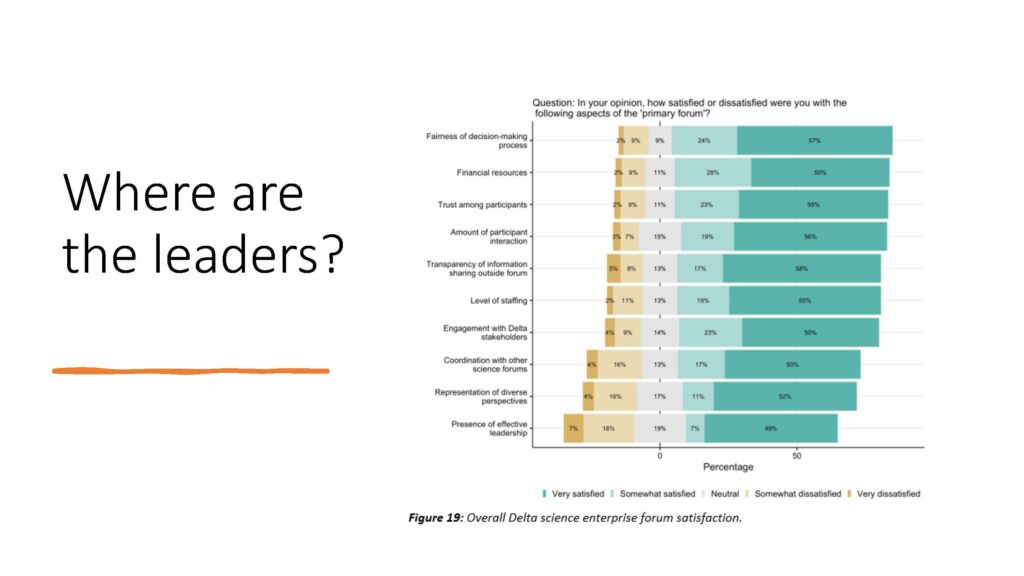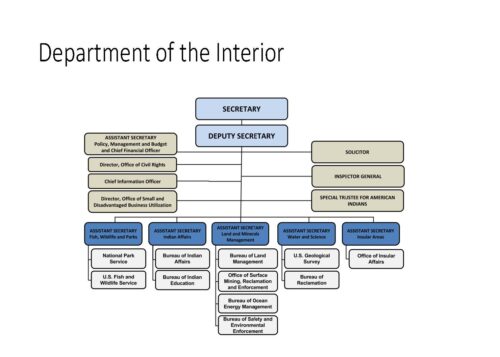In the spring of 2022, the Delta Science Program hosted a series of lunchtime webinars focused on governance in the Sacramento-San Joaquin Delta. The first webinar, held in March, featured speakers from the federal, state, and local levels who discussed environmental governance in the Delta.
Governance is a common topic of discussion in Delta science management and policy circles. It’s also something in which everyone participates in various ways, whether through formal government rules, community coalitions, engagement in public participatory processes, production or communication of scientific research, or any other number of channels.
Yet, even though governance is something everyone participates in, at the same time, we don’t really talk about what it is or what it means. Social scientist scholars have acknowledged that governance is ‘a notoriously slippery term.’ So this series of webinars will reflect on the question, what is Delta governance anyway?
The main goal of this series is to learn and foster discussion about governance in the Delta. Panelists have been chosen to shed light on the social, political, and institutional dimensions of Delta science and management and to explore how institutional structures and processes support effective and equitable environmental management.
Another goal of the series is to raise awareness and understanding of governance as a topic of social scientific inquiry, so each webinar will focus on a different social science framework that can be used to understand Delta governance. The framework for today’s panel is environmental governance, which broadly refers to the processes, structures, and institutions within which decision-making and action for the Delta environment occur.
The panelists:
Dr. Mark Lubell is a Professor of Environmental Science and Policy and the director of the Center for Environmental Policy and Behavior at the University of California Davis. His research focuses on human behavior and the role of government institutions in facilitating cooperation and solving collective action problems that occur when individuals make self-interested decisions that produce socially undesirable outcomes. He has published over 100 articles reporting on theoretical, lab-based, and field-based research using quantitative and qualitative social science methods. Dr. Lubell is highly engaged in advising on Delta environmental policy, serving on the leadership advisory group for BCDC’s Bay Adapts program and Delta Science Program science advisory committee.
Kaylee Allen is the Assistant Regional Director for the fish and aquatic conservation program in the California Great Basin region of the US Fish and Wildlife Service, a position she has held since January 2021. Previously, she served as the field supervisor of the San Francisco Bay-Delta Fish and Wildlife office in Sacramento. Before working with the Fish and Wildlife Service, she served as assistant regional solicitor for the Department of the Interior’s Regional Solicitor’s Office in Sacramento; in that capacity, she advised on legal issues primarily associated with water law, endangered species, administrative law, environmental issues, and torts.
Carl Wilcox recently retired as a policy advisor on the Delta for the California Department of Fish and Wildlife. In this position, he directed the department’s involvement in a range of policy issues related to the state and federal water operations, as well as California WaterFix and EcoRestore. He also participated in multiple collaborative forums representing CDFW, including the Collaborative Adaptive Management Team and the CDFW policy lead for the Interagency Ecological Program. Before his role as a policy advisor, Mr. Wilcox also held positions as Chief of the Water Branch and later the Bay Delta Regional Manager for CDFW. He continues to serve on various advisory councils and committees in the Delta, including the Delta science program’s Science Advisory committee.
Supervisor Don Nottoli, who has served on the Sacramento County Board of Supervisors since 1994, represents District five, which encompasses 650 square miles and includes the city’s Galt Hilton, Elk Grove, and Rancho Cordova, as well as rural farming areas and communities in the southern portion of the Delta. Currently serving his seventh term, Supervisor Nottoli works with people throughout the district and the county to address a range of issues and social services, law enforcement and public safety, recreational and cultural programs, budgetary matters, and programs serving children, families, and seniors. Supervisor Nottoli also serves on various boards and commissions, including as chair of the Delta Protection Commission and a member of the Delta Stewardship Council.
Dr. Mark Lubell: What is environmental governance?
There are many different definitions of environmental governance; the slide lists the most important ones. Most people typically think of it as the rules that may come from legislation, administrative decision-making, or executive order.
“It is the sets of processes and mechanisms and organizations through which political actors influence environmental actions and outcomes, so it’s the rules and structure or how we collectively get together and make decisions that set a rule,” said Dr. Lubell.
When people consider policy changes or legislative actions, they often think about those rules, but there are other ways to think about governance. Some of the main methods:
- Network governance considers the set of actors and organizations networked together in various ways and how action and decision-making are coordinated in the network.
- Collaborative governance emphasizes the role of the drivers and the structures that enable actors to work together across the networks and the different policy forums in which they operate.
- Polycentric governance is the idea that there are many different policy forms and many different actors dealing with many different issues simultaneously and at multiple levels of geographic scale. And they could be cooperating or not within that very complex system.
- Adaptive governance, which adds to the idea of polycentric governance but also considers how governance systems change in response to uncertainty over time, make decisions, get new information, and adapt. It is similar to adaptive management.
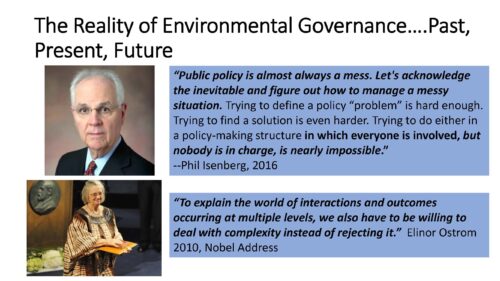 “When you look at the reality of environmental governances out there, it’s almost always quite messy with many different actors and many different policy forms,” said Dr. Lubell. “There’s no one unified set of rules out there that’s integrating everything; we’re always dealing with multiple issues at the same time. And there’s evidence to support this perspective.”
“When you look at the reality of environmental governances out there, it’s almost always quite messy with many different actors and many different policy forms,” said Dr. Lubell. “There’s no one unified set of rules out there that’s integrating everything; we’re always dealing with multiple issues at the same time. And there’s evidence to support this perspective.”
Phil Isenberg, former chair of the Delta Stewardship Council, wrote, ‘Public policies are almost always a mess; let’s acknowledge the inevitable and figure out how to manage this messy situation.’ He characterized policy and environmental governance as situations in which everyone is involved, but nobody is in charge. And that’s a very difficult, if not impossible, problem to deal with. Elinor Ostrom, a Nobel Prize winner in economics, said, ‘To explain the role of interactions and outcomes occurring at multiple levels, we have to be willing to deal with the complexity instead of rejecting it.’
“So the work I do, the advice that I provide people, and the engagement that I do around governance is really trying to help people understand how to deal with these messy polycentric systems and how to navigate them,” said Dr. Lubell.
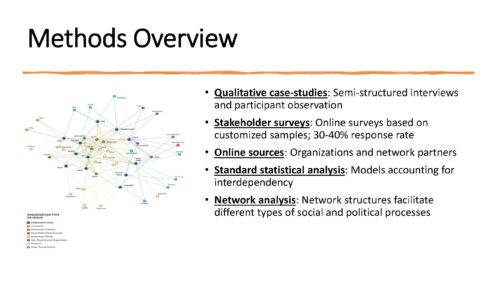 Social scientists use different approaches to studying this, such as semi-structured interviews with key stakeholders and informants, observing participants in meetings, surveys, standard and more sophisticated statistical modeling approaches, and network analysis.
Social scientists use different approaches to studying this, such as semi-structured interviews with key stakeholders and informants, observing participants in meetings, surveys, standard and more sophisticated statistical modeling approaches, and network analysis.
The diagram on the slide was compiled by a former Delta Science Fellow, Matthew Robbins, which shows some of the organizations involved with science in the Delta. The colors describe the different forums, such as collaborative science groups, government agencies, consultants, and NGOs.
“So we look at those networks and think about their structures and who’s most essential and what sorts of structures in there support different sorts of social processes,” said Dr. Lubell.
He then presented three case studies.
Case study 1: Integrated Regional Water Management
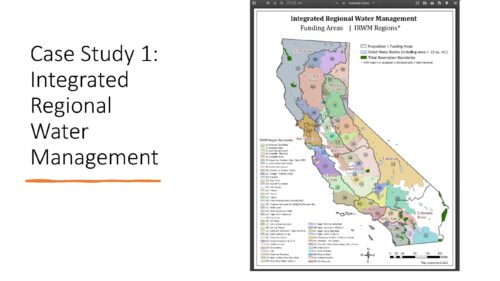 Integrated Regional Water Management is one of the key pillars of the California Water Plan that sets up planning and implementation efforts with multiple groups to fund and cost-share projects that integrate across numerous watershed issues in the region.
Integrated Regional Water Management is one of the key pillars of the California Water Plan that sets up planning and implementation efforts with multiple groups to fund and cost-share projects that integrate across numerous watershed issues in the region.
Dr. Lubell looked at the San Francisco IRWM group, first identifying all the people participating and then sending them a survey.
He noted that many different forms and processes are available for participating in water management and planning in the Bay Area and asked them to nominate up to three. With that approach, over 100 policy forums were identified in the San Francisco Bay around water management.
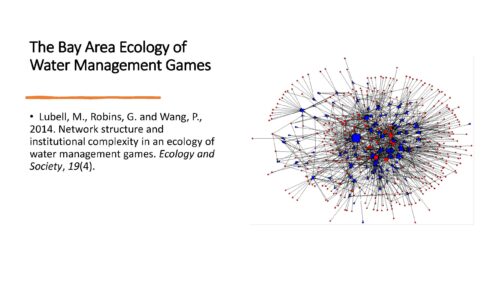 The diagram shows all the policy actors in red who answered the survey or identified as participants; the blue squares are the policy forums. IRWM was the largest; Cal Fed is the second largest as existed at the time the survey was done.
The diagram shows all the policy actors in red who answered the survey or identified as participants; the blue squares are the policy forums. IRWM was the largest; Cal Fed is the second largest as existed at the time the survey was done.
“Basically, every watershed in the country has some variants of this messy system,” said Dr. Lubell. “When you do the analysis on this, you’ll see that there are structures in here that support both learning and information sharing and cooperation. So these are multifunctional complex polycentric governance systems. This is the reality.”
“When I show it to people, I often feel this is a form of therapy. It’s kind of like the Rorschach tests that people look at. What do you see in this? And a lot of people say, finally, somebody has recognized how complicated these systems are. They get it. Then they look at me and say, how do we solve these sorts of problems? Because this is the Gordian knot of governance right here. How do you cut through this and get something done? That’s a difficult problem.”
Case study #2: San Francisco Bay Sea Level Rise Adaptation
Sea level rise and climate adaptation is a key issue in the Bay Area, and many planning efforts are working to address it. Dr. Lubell surveyed sea level rise stakeholders, asking them to select the top three problems they wanted to see addressed and the solutions.
“What you see is they all want a plan,” said Dr. Lubell. “They all want collaboration, but nobody wants a regional authority. So they all want to get together and cooperate, but they don’t want anybody to tell them what to do about it. So how do you deal with a system where nobody wants to give up any control or authority?”
Dr. Lubell analyzed the adaptation plans and divided them into different periods. “It started as a sparse network; the Bay Area IRWM was starting to talk about sea level rise. Then over time, this network has really grown; a lot more local programs have come in, and a lot more local actors have come in. So it shows the growth of a regional governance system for sea level rise in the Bay Area, but it’s not essentially a process of centralization, where some central actors are taking control of everything. Rather, it’s more of a process of decentralization. The growth is in the local actors connecting to local venues and regional actors connecting to local venues.”
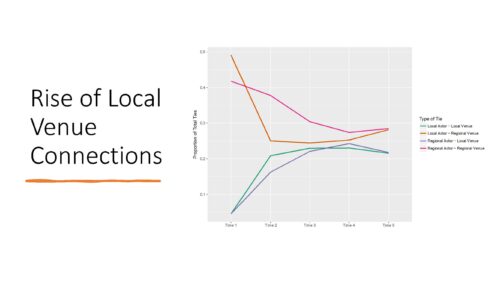 Similar to downscaling climate effects, this is downscaling in governance. It’s bringing the regional problem downscaled to the local level and bringing regional resources to the local level to shape the behavior of all those local governments and special districts in the Bay Area. It is a very fragmented system at the local level.
Similar to downscaling climate effects, this is downscaling in governance. It’s bringing the regional problem downscaled to the local level and bringing regional resources to the local level to shape the behavior of all those local governments and special districts in the Bay Area. It is a very fragmented system at the local level.
Case Study 3: Governing Science for Policy Learning and Adaptive Management
In looking at governing science for policy and adaptive management in the Delta science enterprise, Dr. Lubell used all the various collaborative science forums in the Delta as the gateways to sending out a survey. The responses are shown on the slide.
“There are a lot of different programs, such as the IEP and DPIIC, where science is communicated and developed in the science enterprise,” said Dr. Lubell. “The science enterprise is supposed to help support the implementation of the adaptive management framework of the Delta management plan.”
The survey asked participants to name the central forum and evaluate how effectively it pursues the elements of the adaptive management cycle: plan, do, evaluate, and respond. 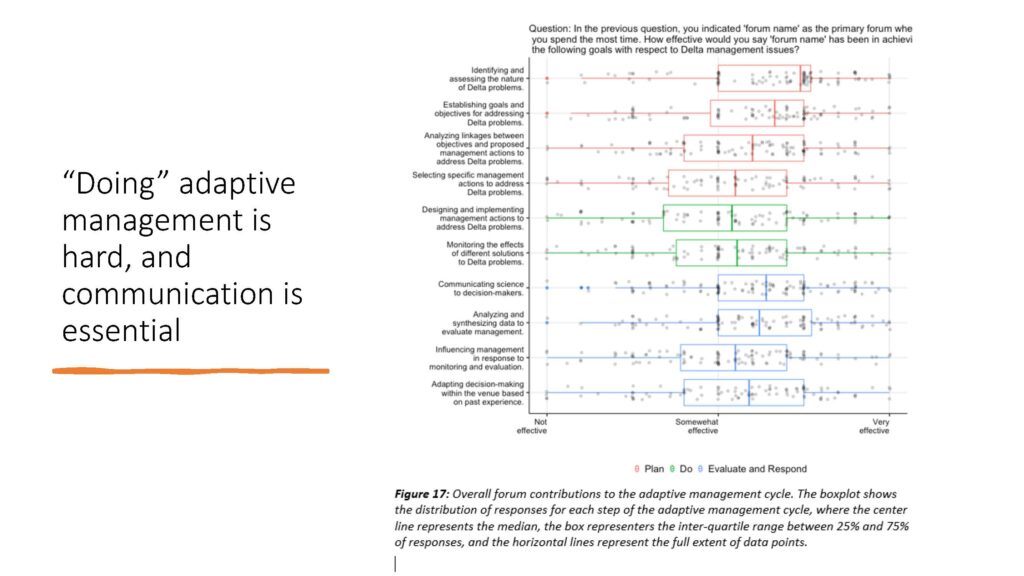
“They were all rated at somewhat effective, but they all are rated as doing the bet on identifying the nature of Delta problems, but not as well rated on the do part or actually getting something done. A little bit better rated on the evaluate and respond. An interesting piece for me is that all of them are viewed as doing pretty well in communicating science and analyzing and synthesizing data. So throughout that adaptive management process, through all these different sites and forums – communication and translation are key.”
Participants were also asked about the barriers to adaptive management or how satisfied they were with the various drivers. “You can see that they thought they were fair, it had decent financial resources, and trust was pretty good, but at the bottom is the presence of effective leadership and representation of diverse perspectives in coordination with the other science forums out there,” said Dr. Lubell. “So it’s dealing with that messy situation.”
“When you show which of these drivers are the most important in predicting the success of adaptive management, the most important drivers are leadership, trust, and fairness. The least important drivers are actually the financial and staff. So when you look at the function of the science enterprise with respect to adaptive management, the financial and staff resources that people spend a lot of time talking about appear to be less important than the social processes of leadership and trust.”
In conclusion …
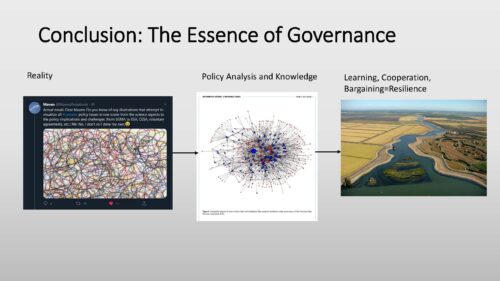 “So we take a social science approach to understanding these systems by having ways to measure them, having ways to analyze them, and we hope by doing that, that we generate some knowledge about how these systems operate, their structure and function,” Dr. Lubell said. “And by using that knowledge, we can help untie those Gordian knots and help people build and navigate governance structures in ways that enhance learning and cooperation, increase capacity to come up with equitable solutions, and negotiate and bargain across all the costs and benefits. We think those are the processes that we need to have resilient social-ecological systems in the Delta and other places as well.”
“So we take a social science approach to understanding these systems by having ways to measure them, having ways to analyze them, and we hope by doing that, that we generate some knowledge about how these systems operate, their structure and function,” Dr. Lubell said. “And by using that knowledge, we can help untie those Gordian knots and help people build and navigate governance structures in ways that enhance learning and cooperation, increase capacity to come up with equitable solutions, and negotiate and bargain across all the costs and benefits. We think those are the processes that we need to have resilient social-ecological systems in the Delta and other places as well.”
Kaylee Allen: Governance at the federal level
Kaylee Allen then gave a brief overview of the structure of the Fish and Wildlife Service and the Department of Interior, and the touch points of where federal agencies may be engaged in Delta issues and Delta governance. Most of her comments will be based on personal lessons learned about the state and federal relationship from the various iterations of Cal Fed. These are her thoughts and don’t represent policy positions of the Fish and Wildlife Service or the Department of the Interior.
The slide shows a high-level overview of how the Fish and Wildlife Service is structured. The Fish and Wildlife Service is divided into programs; Ms. Allen is in the Fish and Aquatic Conservation Program in the Pacific Southwest region. The program manages hatcheries in the region, data collection and monitoring, and restoration efforts.
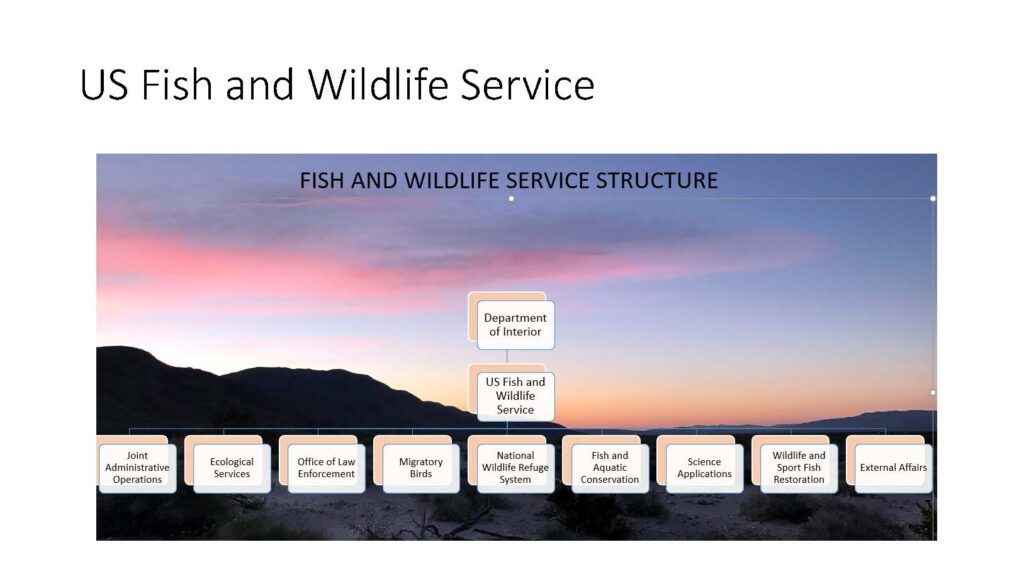 At the national level, there is a director, Martha Williams. Each region has a director; the regional director for the Pacific Southwest region is Paul Souza. There are deputy directors at the national level and regional deputy directors at the regional level. There are assistant directors and assistant regional directors as well.
At the national level, there is a director, Martha Williams. Each region has a director; the regional director for the Pacific Southwest region is Paul Souza. There are deputy directors at the national level and regional deputy directors at the regional level. There are assistant directors and assistant regional directors as well.
Ms. Allen noted that oftentimes, if you’re dealing with multiple people at the Fish and Wildlife Service, you are dealing with people in various programs. “Just like all big agencies, we’re not always the best at talking to each other,” she acknowledged.
The slide shows the basic structure of the Department of the Interior. The Secretary and Deputy Secretary are at the top; there are assistant secretaries over various agencies. The Fish and Wildlife Service is under the Assistant Secretary for Fish, Wildlife, and Parks, along with the National Park Service. The Bureau of Reclamation and the USGS are under the Assistant Secretary for Water and Science.
“At various times in my career on Delta issues, sometimes the Secretary and the Deputy Secretary are heavily involved,” said Ms. Allen. “Other times, it is the Assistant Secretary for Water and Science who tends to take the lead role, or the Commissioner of reclamation – one of those two will tend to lead efforts in the region.”
Some authorities where federal agencies may engage in Delta governance include:
- USFWS – Endangered Species Act, Central Valley Project Improvement Act, Fish and Wildlife Coordination Act (FWCA)
- Reclamation – Central Valley Project, Section 8 Reclamation Act
- Army Corps – Rivers and Harbors Act, Clean Water Act
- EPA – Clean Water Act
- NMFS – Endangered Species Act, Magnuson Stevenson, Coastal Zone Management Act
“We need to implement our authorities, and that creates the spaghetti chart that Mark showed, where there’s a lot of different forums and a lot of different players, but not always are the same agencies in the same forums,” said Ms. Allen. “But there’s definitely a lot of Acts and laws that we’re implementing that give us a foray into the Delta.”
Thinking back to the Cal Fed Bay-Delta program, it was a consortium of state and federal agencies conceived in the mid-90s who were working to ‘fix the Delta.’ The program was primarily tasked with developing a program to improve Delta conditions and to study that. So the staff was preparing NEPA and CEQA documents to study the program they had developed.
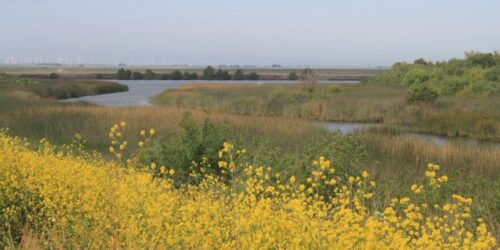 “At the time, there was no legal entity that was the program,” Ms. Allen said. “It was staff from each of the agencies that were participating that were co-located and working together to develop that program. And I think that structure actually worked pretty well.”
“At the time, there was no legal entity that was the program,” Ms. Allen said. “It was staff from each of the agencies that were participating that were co-located and working together to develop that program. And I think that structure actually worked pretty well.”
“Where it didn’t work so well is that there was no cognizable legal entity that was the Cal Fed Bay-Delta Program. So they couldn’t take action. They couldn’t let contracts. They couldn’t do the things that government generally does to implement a program.”
The study phase worked pretty well; there were various structures to guide the development of the program and a federal advisory committee led by the Secretary. The program itself was a high priority within the Department of the Interior, with both Secretary Bruce Babbitt and Deputy Secretary David Hayes engaged in Delta issues and in the Cal Fed program.
The NEPA and CEQA documents led to a Record of Decision in 2000. Federal legislation was then needed to codify the program so they could move forward; unfortunately, the federal legislation didn’t come until 2004. That created multiple issues on the federal side. One was the change in administration with the election in 2000, and the Delta was not a high priority for the next administration.
“We also didn’t have a governance structure that could support one side shifting away,” said Ms. Allen. “At the time, for the feds to really participate in any sort of governance structure that actually has decision making and authority, we need congressional legislation to be able to do that. We can participate in the collaborative forum, but to really create the legal entity that was Cal Fed, we needed federal legislation that didn’t come.”
All of those things conspired to slow the progress of the program. When the federal legislation did come in 2004, it was more around funding and authorities to take action, but it didn’t really address governance. So the state passed legislation in 2002 that created the California Bay-Delta Authority as a state agency. The Act did contemplate federal participation, but with no mechanism in state law to make federal agencies participate, the level of involvement that was envisioned didn’t occur. This led to more federal disengagement from the program.
The 2009 Delta Reform Act created the Delta Stewardship Council and the Delta Science Program. “From my perspective, the processes became a bit more opaque with that change. From the federal side, there were just a lot more entities doing what seemed like a lot more things, and it’s been harder to track and to know where best for us to insert ourselves and be useful.”
At the time, there were a lot of endangered species issues in the Delta and litigation over the biological opinions that took a lot of time and energy. The Bay Delta Conservation Plan was being developed, which seemed to be the focus of the federal agencies at the time.
“The Delta Stewardship Council had been doing a lot of work in that time, but we weren’t necessarily a part of all of it. So it’s been harder to keep up, at least from my standpoint.”
In closing, Ms. Allen said concerning the function of the government entity and the performance aspects, the influence of the election cycles cannot be understated especially because the presidential cycle and Governor cycle are off.
“So you really only have two years in each cycle that things can be accomplished, potentially, if the state and federal administrations are so inclined,” she said. “So I think legislation really does help create that permanence. And it can define more clearly what federal functions would be in terms of governance.”
“However, I also think there’s a lot we can accomplish with collaboration without that joint decision making or more set structure. I think a lot can be accomplished, but each agency needs to retain its own decision-making, and that can cause issues at times. But I think we as agencies generally work pretty well together.”
“So when we’re thinking about governance, it helps to define what we are trying to accomplish with any given government governance structure. What is needed? Do you really need legislation? And if you do, then that’s a long road to get that through Congress.”
Carl Wilcox: Governance at the state level
The Department of Fish and Wildlife is the trustee for the state’s fish and wildlife resources. The Department began as the Wildlife Commission in 1870, a program to look and protect and conserve fish and wildlife resources, particularly as it related to dam building, maintaining fisheries, and fish and wildlife resources. The Wildlife Commission is in the state constitution.
The Department’s mission is broadly focused on the conservation of species, plants, animals, and the habitat they depend on. The activities are prioritized by statute, regulations, and funding availability to implement those mandates.
“That’s a key component to keep in mind with, at least with the Department,” said Mr. Wilcox. “Our ability to implement programs is often driven by the ability to fund them. We may have the mandate, but we may not have the funding to implement that effectively. And the department’s budget is subject to appropriations by the legislature as part of the state budget.”
Much of the Department’s work historically has been funded by fees, such as hunting or fishing licenses and fees from some of the regulatory programs. “That tends to be a controversial area, but also one that limits our ability as an agency to work more independently to engage with communities. So if your funding is tied to a specific funding source, that limits your activities; you can’t be doing something else that may be more focused on community engagement. And you’re focused primarily on writing permits or something like that.”
Structure of the Department of Fish and Wildlife
The Department of Fish and Wildlife is part of the Natural Resources Agency, which houses 43 entities responsible for managing the resources in the state of California. He noted that not all resources agencies are part of the Natural Resources Agency; the State Water Resources Control Board, for example, is housed within Cal EPA. State agencies related to the Delta are the Department of Water Resources, the Delta Stewardship Council, the Delta Protection Commission, and the Delta Conservancy.
The Department has a Director, a Chief Deputy Director, and then is divided into two major program components related to resource management:
- The Ecosystem Conservation Division includes a water branch focused on water-related activities, particularly operations of the state and federal water projects, instream flow, and providing advice to the State Water Resources Control Board. It includes a habitat conservation planning branch that works on large-scale conservation and oversees many of the department’s regulatory programs.
- The Fish and Wildlife Division primarily focuses on species management, habitat management, and overseeing hunting and fishing programs within the Department.
The Department has seven regions within the state, which are geographical areas that implement the programs and policies at the local level. The Department’s Bay-Delta region was created in 2006 to tie San Francisco Bay to the Delta and to integrate activities across that region. Mr. Wilcox acknowledged it’s a very diverse region; the conservation and management perspective in San Francisco Bay is very different than in the Delta.
“I spent 20 years working in San Francisco Bay before engaging in the Delta,” said Mr. Wilcox. “It was a very different place just because of the composition: an urban-centered environment, and looking at its resources and how to protect it as opposed to a more rural-based setting where people are interested in Delta as a place; they’ve all grown up in it and they view it as cherished to them. It’s similar to the way people on the bay look at the edge of the bay but from a different lens. So all things related to conservation planning need to consider that as they go forward.”
Policy direction and implementation
As far as policy direction, the Department is guided primarily by statutes and regulations. But policy is also provided by the Fish and Game Commission, which establishes hunting and fishing regulations and makes decisions about the listing and state of threatened and endangered species in the state.
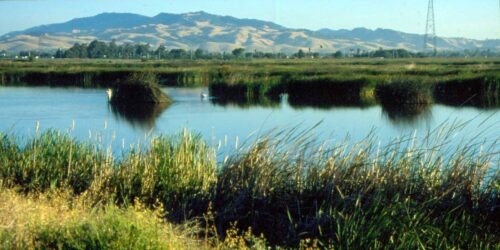 Endangered species also operate under policy guidance from the Governor’s office and the Natural Resources Agency, such as the California Water Action Plan, Cutting the Green Paper initiative to facilitate restoration planning and implementation within the permitting structure, and the Delta Smelt Resiliency Strategy. AB 2402 mandated the Department manage and look at things from an ecosystem-based management structure and apply adaptive management, and ecosystem-based management that focuses on fish and wildlife resources in a social context within the community and how those things are integrated.
Endangered species also operate under policy guidance from the Governor’s office and the Natural Resources Agency, such as the California Water Action Plan, Cutting the Green Paper initiative to facilitate restoration planning and implementation within the permitting structure, and the Delta Smelt Resiliency Strategy. AB 2402 mandated the Department manage and look at things from an ecosystem-based management structure and apply adaptive management, and ecosystem-based management that focuses on fish and wildlife resources in a social context within the community and how those things are integrated.
The Wildlife Conservation Board is also a component within the department that supports its conservation actions through grant making as a funding source.
Managing fish and wildlife resources
The Department’s primary activity is the trustee role, which applies particularly to how they address regulatory programs and implement grant-making programs, which included habitat restoration as part of the Cal Fed program and supporting wildlife-friendly agriculture. The Department also manages over a million acres across the state, of which 30-40,000 acres are within the Delta and Suisun Marsh.
The Department provides advice to other state agencies as their activities relate to fish and wildlife resources. This includes providing input into processes such as the California Water Plan, land use plans, and general plans. The Department also provides input on the planning and implementation of projects and how those agencies make their decisions relative to those projects as they affect fish and wildlife.
“In many cases, what they approve may ultimately have to come to the Department to get a permit,” said Mr. Wilcox. “So we try to work in advance or as early as possible within the process to incorporate the Department’s concerns and fish and wildlife conservation measures to ensure that once it gets to us, it’s permittable. That is critical in our role under the California Environmental Quality Act, where we serve as a trustee to provide advice. But we also serve as a responsible agency where we have permitting authority. We’re also the lead agency on our own projects.”
One of the key challenges in effective governance within the Delta from a state perspective is having the resources to effectively collaborate and conduct outreach regarding the Department’s programs. This includes having the ability to engage as a state in sustained interactions to develop plans that are acceptable. Those efforts take extended periods of time to develop to get to implementation, he said.
“One of my most rewarding experiences was working on the East Contra Costa County Conservation Strategy Plan,” said Mr. Wilcox. “It was probably the fastest developed Habitat Conservation Plan in the state’s history, although it’s not recognized that there was probably 10 years of pre-work that set the stage for that to be able to come to fruition.”
The Department strives to coordinate closely with its state and federal counterparts, such as the Fish and Wildlife Service and the National Marine Fisheries Service. Since they co-manage many resources together, including operating hatcheries, it requires a great degree of interaction to ensure they are not working at cross purposes.
They also try to coordinate when there is overlapping permitting authority, particularly under the Endangered Species Act. The California Endangered Species Act lists species, as does the federal Endangered Species Act. Where species are co-listed, the Department works to provide authorizations, and when there are differences between the two, they need to be coordinated to make them work together. The Department encourages larger conservation and landscape planning, but it does take a lot of intensive interaction over many years to make those efforts work.
The multi-level environmental governance in the Delta is very complicated. “Many decisions get made at the state or federal level and are not really subject to that much local engagement,” Mr. Wilcox said. “It has to be recognized that it’s important to make those connections, although there are some fundamental differences in how people on the Delta look at things relative to the broader statewide perspectives or the limited roles of a particular permitting agency. Conflicts arise with habitat restoration that have existed since the Cal Fed days of what is habitat restoration in the context of the Delta and how implementing restoration affects local economies and the agricultural community, particularly in the rural setting; those are key considerations.”
Accountability
Regarding holding agencies accountable, the Delta Plan consistency requirements provide a level of accountability that was not there before the Delta Reform Act. From a science perspective, the Independent Science Board is charged with overseeing the effectiveness of adaptive management in the system and reviewing and providing scientific guidance more broadly.
Most of the Department’s actions or interactions are at the state and federal levels. Still, they are engaged in the Yolo Bypass Cache Slough partnership, as well as other science-related partnerships within the greater Central Valley. “I think those are the types of venues that can be most effective in resolving landscape issues and engaging more effectively with local agencies in government, whether it’s county level, city level, or with reclamation districts.”
The California Environmental Quality Act requires agencies to go through a public vetting process of their activities and reveal the effects of what their actions might be. This applies to the Department for project implementation and adopting regulations.
Coordination
Regarding coordination, Mr. Wilcox said the state is increasingly recognizing that effective coordination needs to take place with local governments. “The difficulty in many cases is that there isn’t necessarily a common ground, and there’s a lack of trust. Trust building is difficult. It really takes a lot of effort to build effective relationships between governmental agencies at all levels.”
The Delta Plan Interagency Implementation Committee (DPIIC) provides an opportunity for greater coordination. The DPIIC brings together state and federal agencies working within the Delta and involves a local perspective through the participation of the Delta Protection Commission and the Delta Stewardship Council.
More opportunity for coordination comes through collaborative planning activities, such as the Delta Conservation Framework. Mr. Wilcox noted that they push for that when issuing grants within the Delta. It is important to provide resources to local agencies and tribal communities to engage as a partner in planning activities.
Mr. Wilcox suggested some examples of ways to deal with governance issues:
- The Yolo Bypass Cache Slough partnership is a state, federal, and local effort to come up with a conservation strategy that addresses multiple benefits within the Yolo bypass and Cache Slough, such as flood protection, fish enhancement, and wildlife management, and addressing regulatory issues that may arise from implementing conservation.
- The Delta Conservation Framework, developed by the Department, encourages locally driven conservation planning by engaging with the community to look at multiple benefits associated with conservation planning. The Franks Tract planning effort is an attempt to apply that effectively.
- The Suisun Marsh Restoration Management Plan was another long, tedious process that ultimately developed a plan with broad stakeholder acceptance within the marsh.
Sacramento County Supervisor Don Nottoli: A local perspective
Don Nottoli began by saying that it’s clear there are dozens and dozens of multiple agencies and responsible parties, and yet there are different layers too. Sacramento County was established in 1850 and has evolved over the past 172 years as a local government entity as society evolved in how the county is governed and arrives at decisions in light of all those multiple layers and multiple responsibilities.
“One of the themes I take away from my colleagues is the focus on trust,” he said. “It’s time-consuming and requires a lot of work, but I’m a big believer, certainly as one who served in local government, working with colleagues and their agencies and a multitude of others, I think it’s very important to recognize that the role that we play and where we come into it. The agencies and or entities we represent have a public responsibility by the very charge they were given. Whether it be a very distinct role in a special district, or the broader role that a county or city might have related to municipal or county-wide services, or state and federal agencies that have very broad responsibilities, there are multiple layers.”
Even as challenging as it may be, Mr. Nottoli said in his experience that achieving a basis of trust does help advance things. “Yes, you have a messy, messy situation, and you’re trying to find effective leadership, but those relationships and that basis of trust are very important,” he said.
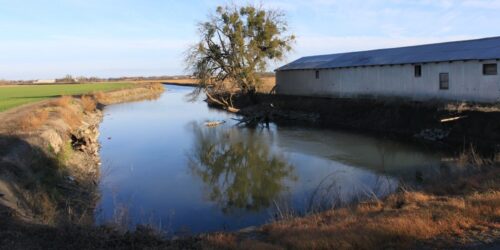 Five Delta counties comprise 4 million of the 40 million Californians; about half a million folks reside in the Delta. Some are in incorporated cities, and others live in rural settings and legacy communities that are part of the early settlement in the Delta.
Five Delta counties comprise 4 million of the 40 million Californians; about half a million folks reside in the Delta. Some are in incorporated cities, and others live in rural settings and legacy communities that are part of the early settlement in the Delta.
“The Delta is a place of certain unique attributes,” said Mr. Nottoli. “It’s a place of wonder and awe. It’s also a place that folks call home their daily lives. It has the rural intermixed with the more urbanized perimeters and some of the cities that are within the legal Delta. But it is a place of a lot of focus which is a benefit, particularly with some of the challenges that we see.”
Regarding environmental governance and how we get to solutions and best utilize the resources to various levels, Mr. Nottoli said one of the challenges he has observed is that folks have defined roles in the decision-making, but it may deflect the ability to move as quickly as one would like. But if folks share in the decision-making, as difficult as it might be to achieve at times, and if the focus is on trying to find the solutions, not just what the statute calls for, there are wins that come with that, even with all the multiple layers.
Back in 1992, the Delta Protection Commission was first established. It was unique from other state agencies as there was local representation with county supervisors, city council representatives, regional representatives, and reclamation districts seated with state agencies. The Delta Reform Act in 2009 established the Delta Stewardship Council and the Delta Conservancy.
The Delta Reform Act created a structure where there are multiple layers. The Delta Plan requires the integration of the Land Use and Resource Management Plan that the Delta Protection Commission is charged with. And local general plans have to be consistent with the Delta Land Use and Resource Management Plan and then with the Delta Plan.
“I have colleagues from the other four Delta counties, which include San Joaquin, Solano, Yolo, and Contra Costa, in addition to Sacramento, who share in some of the representation on those bodies, but I think there has been a recognition of contributions of the local decision-makers that are elected. That can sometimes bring a parochial perspective, which gets meshed with a broader regional or statewide perspective,” said Mr. Nottoli. “I think it’s been healthy.”
In the Delta, there are different points of view regarding restoration efforts. From the Sierra to the sea, the Delta is at a critical pivot point from a natural environmental setting and an altered landscape with levees where water is moved from north to south, into the bay, and into the sea.
“It’s a critical point of demarcation not only from political and environmental but from the standpoint of daily life,” said Mr. Nottoli. “One of the roles of a local representative is to attempt to be a clear voice for folks and the local perspective, but also to work for solutions with those agencies and entities, of which there are a multitude, to find solutions to things that are embedded in state or federal law. So, I’m encouraged that I have seen a lot of effort put forward in reaching out to local agencies during my terms of service. The reliance and emphasis on science has been very helpful to local efforts, and it informs all of us, whatever our respective role.”
Mr. Nottoli then noted two achievements that the Delta Protection Commission has accomplished, along with some help from other state and federal entities.
The Great Delta Trail: Recently, the Delta Protection Commission adopted the template for the Great Delta trail. The effort is supported by state legislation and has been ongoing for many years. It will create a continuous regional recreational corridor extending through the Delta, including the shorelines in all five Delta counties, and linking the San Francisco Bay Trail system to the Sacramento River trails in Yolo and Sacramento Counties. The Great Delta Trail is also intended to connect to parks and recreational facilities and land and water trail systems throughout the Delta.
The Delta National Heritage Area: The Delta has been designated as a National Heritage Area, a federal designation. The Delta Protection Commission is developing the resource management plan to submit to the Department of Interior later this year. “It doesn’t impose necessarily another layer of governance on the Delta,” said Mr. Nottoli. “But I think it will bring a focus of the importance of the Delta’s values that in state statute and those that are important to daily life in the Delta. … It was a major achievement that required tremendous cooperation at various levels.”
Mr. Nottoli said there’s a reason to be very hopeful. “Even though representation can vary from political cycle to political cycle, I know that the counties, local districts, and communities are committed to their work at the various levels in which they are represented.”
It will take communication, hard work, and dedication to achieve environmental restoration goals and maintain community life. “We need to establish a basis of lasting trust so then we can manage a messy situation, and I’m hopeful that we can advance the state of goals of ensuring and achieving the water supply reliability and ecosystem restoration in a way that protects and enhances the values of the Delta that are very, very important.”
QUESTIONS & ANSWERS
Dr. Lubell introduced the social science concept of multi-level governance, Kaylee Allen and Carl Wilcox discussed state and federal levels of governance, and Don Nottoli spoke from the local perspective. How does this multi-level coordination work, and what are the biggest opportunities for improving that coordination across levels of governance?
“It’s about building trust and getting to know people working with them where they’re at,” said Kaylee Allen. “We do participate with local entities when we’re invited to do so. And so there are those opportunities, but we each have to take the time to build those relationships.”
Don Nottoli noted that sometimes relationships are developed, and then the direction is changed from a level higher up, beyond people’s control. “Our respective role is fulfilling commitments that are made, whether they are embedded in agreements or in law. It’s really important. Part of the challenge with folks at the local level is that they see things that are promised that are embedded in law, and then they also see where there’s a breach. And it can be fairly significant. It’s not because they’ve been intended to do it, going into it, but when it comes to water policy, it gets to be very, very, very challenging.”
“Efforts to build a foundation may have a setback from time to time, but it allows you to make forward progress in a way that people pull together a lot of the issues, even if they have differences and maybe strongly held on certain aspects of public policy,” added Mr. Nottoli.
Carl Wilcox pointed out that much effort was put into engaging the local community on Franks Tract planning efforts that addressed the ecosystem and recreational interests, but nothing is happening as of yet. “We need to be able to sustain these kinds of planning efforts and carry them forward to some actual fruition. It goes back to leadership. We don’t have a leadership component there to take it to the next steps, whether it comes from the local community that says that we spent time on this, we think it makes some sense, and getting the resources to further that planning effort. I think it’s an example of how we have to pursue ecosystem restoration within the Delta because we’ve done all kinds of easy stuff around the edges. So we have to work on fundamentally changing the structure of the Delta to overcome some of the consequences of reclamation.”
“From my perspective, we need to train more leaders about how to navigate these systems,” said Dr. Lubell. “One of the things that is a gap in all of this is that often when we talk about improving coordination, somebody says, let’s create a new forum or some new structure, and that’s sometimes worth it. But we have lots of structures and lots of projects of various sorts. So developing more leadership training so people can think about these systems and how to navigate them. And the importance of things like trust can really help get people working together more effectively, within the structures to think more carefully about when it’s appropriate to change or create new ones.”


